1 FREQUENCY ELECTRONICS, INC. Rb and Quartz Oscillators
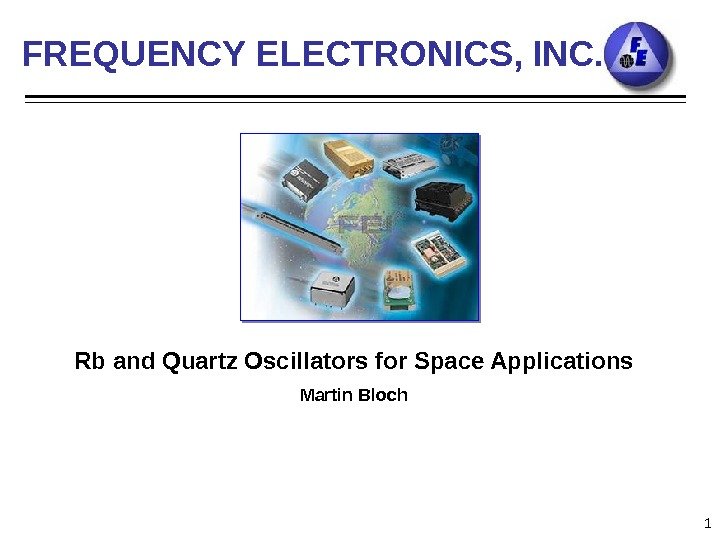
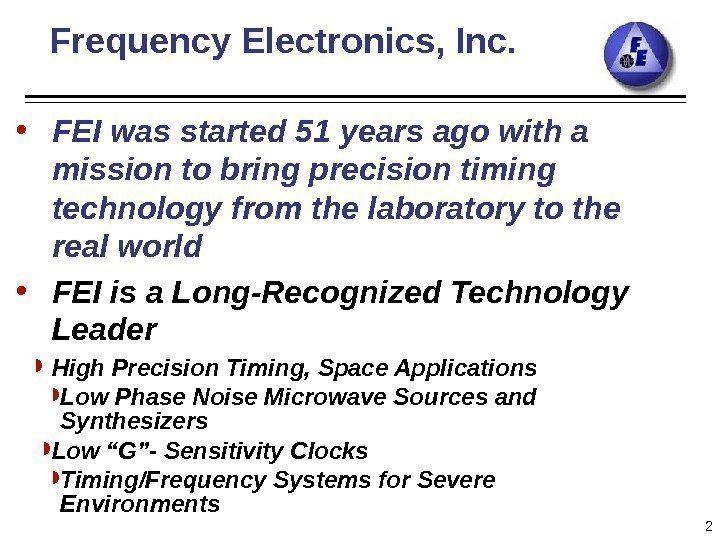
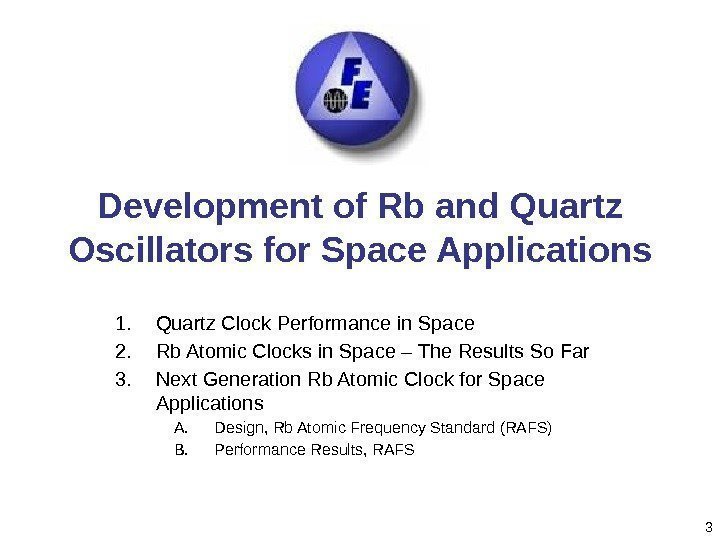
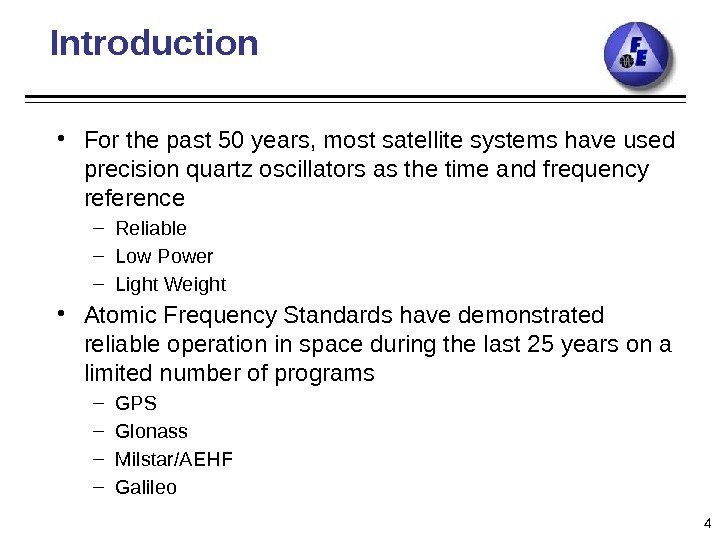
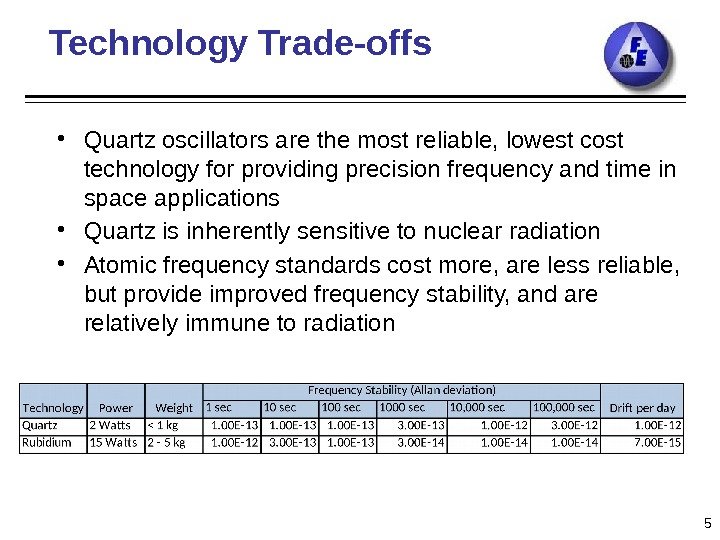
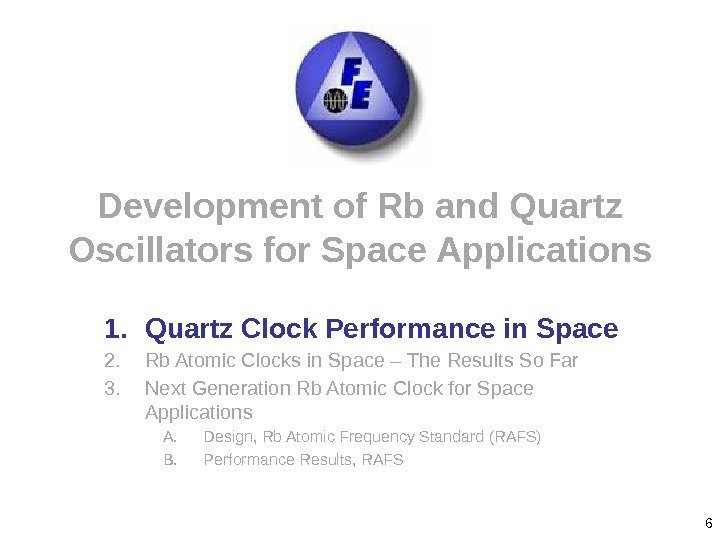
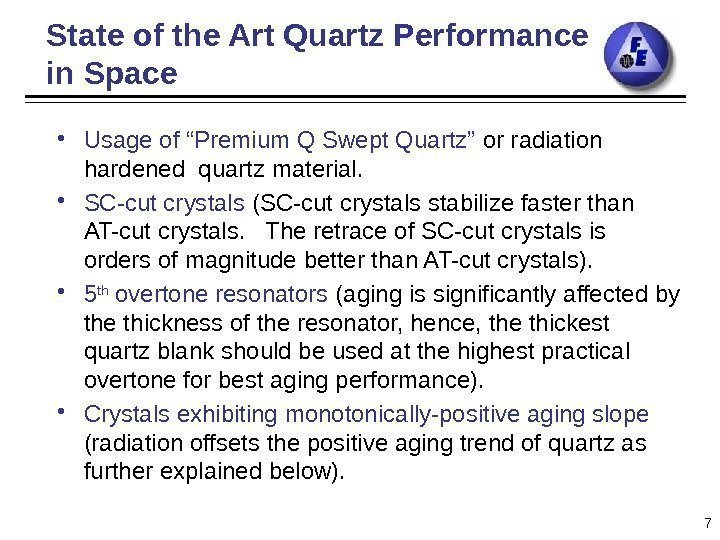
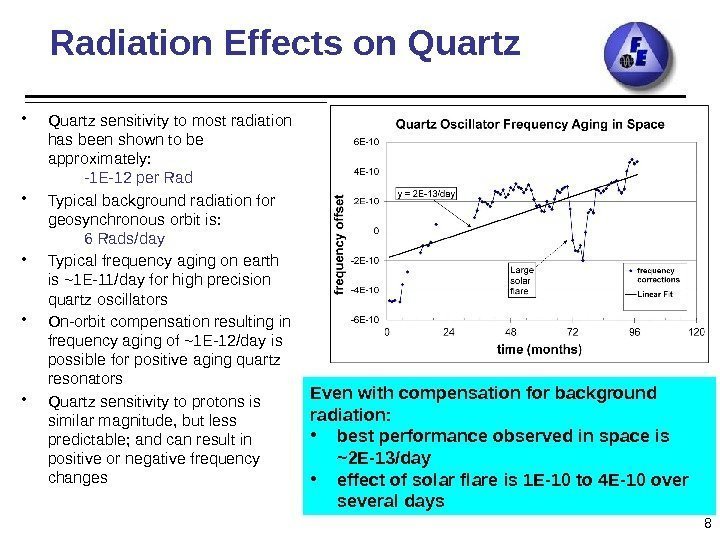
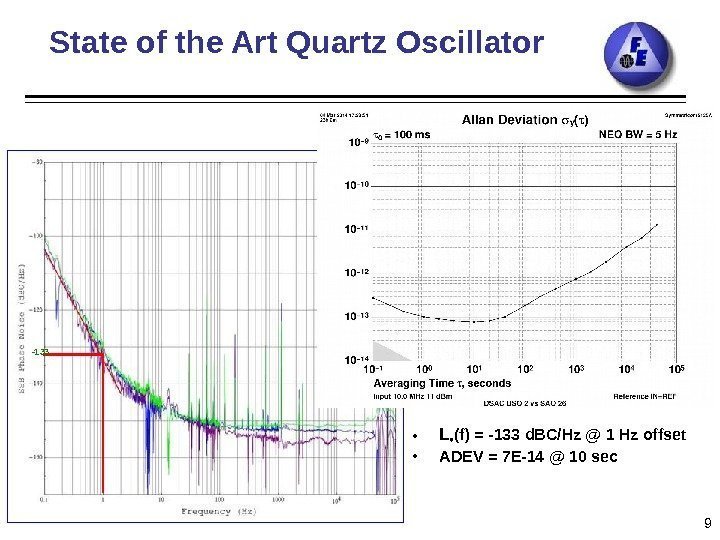
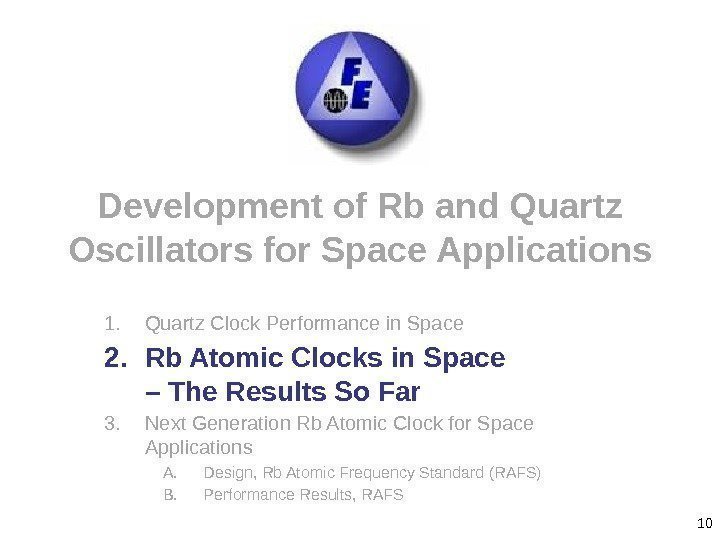

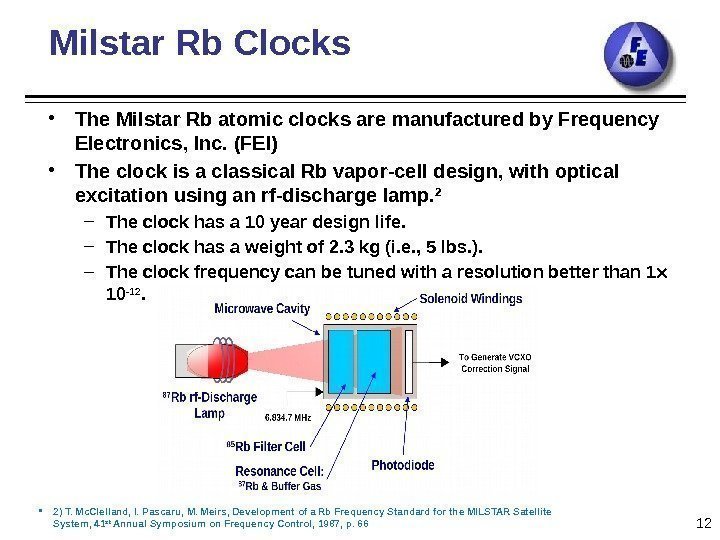
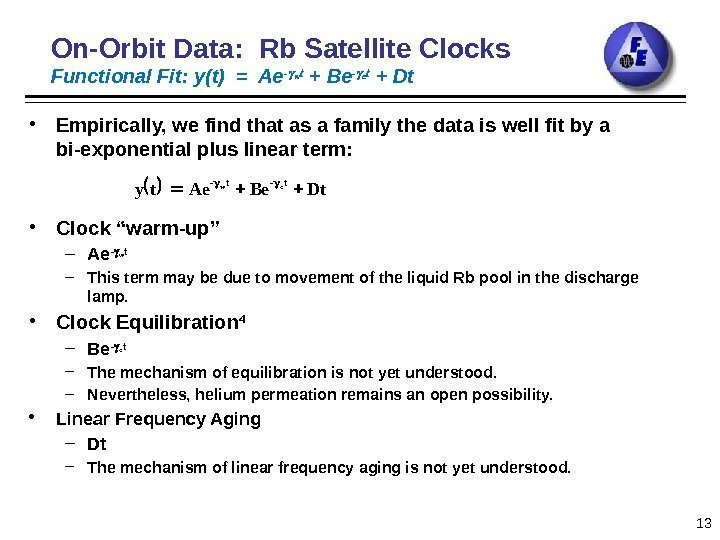
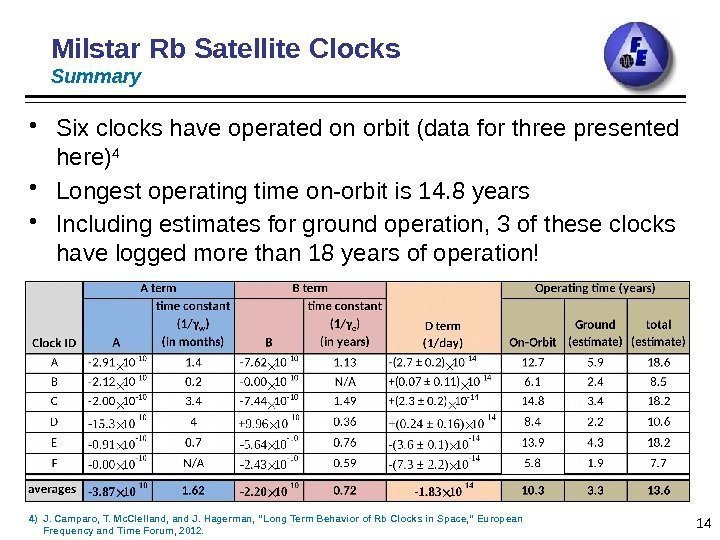
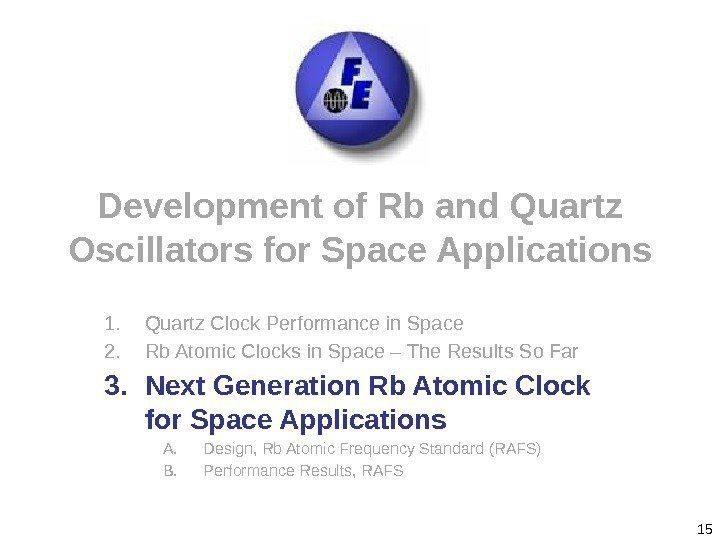
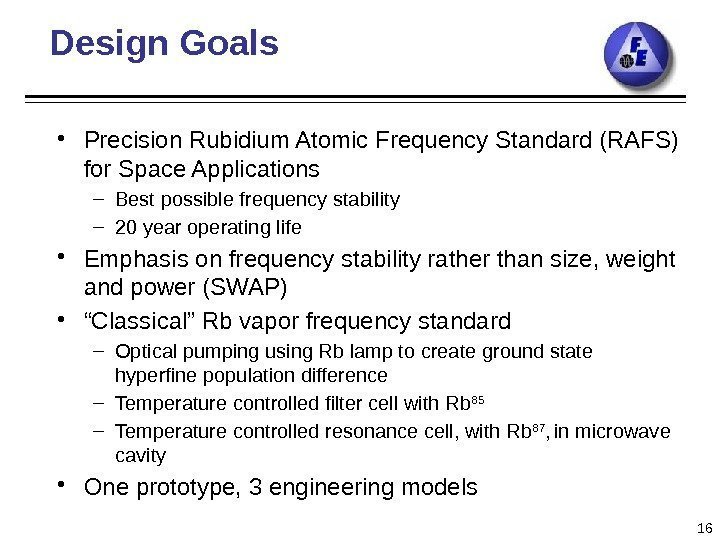
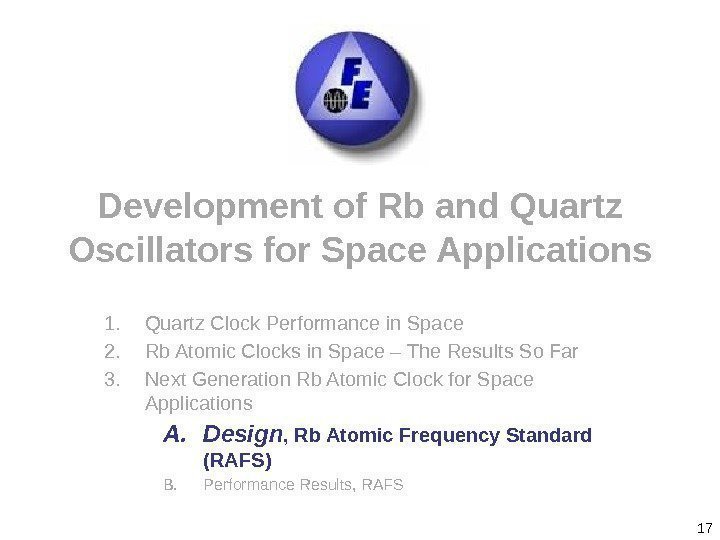
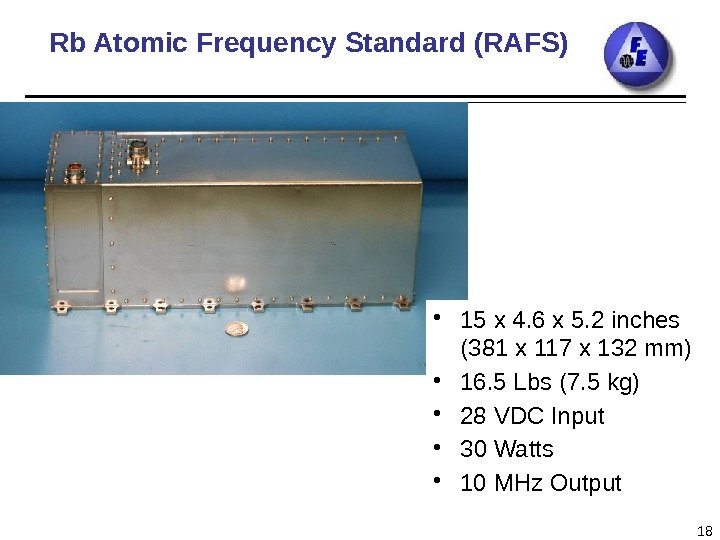
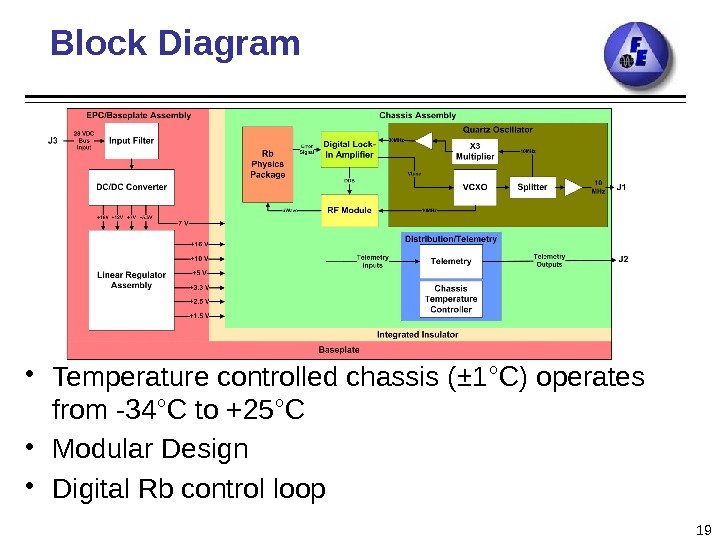
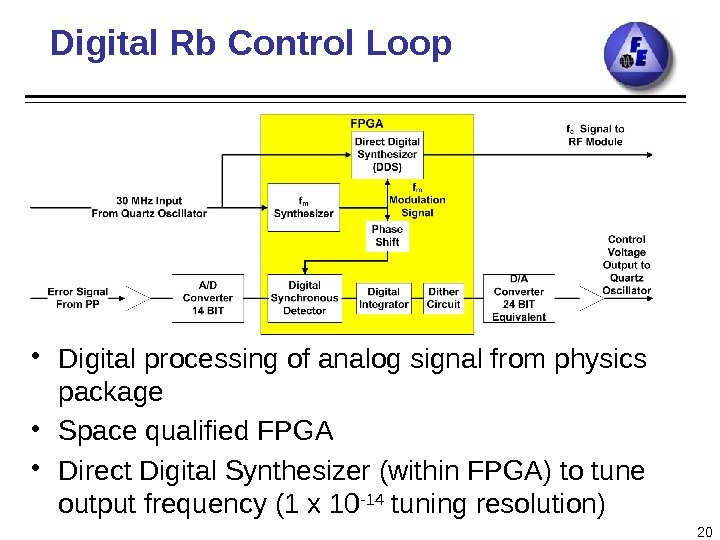
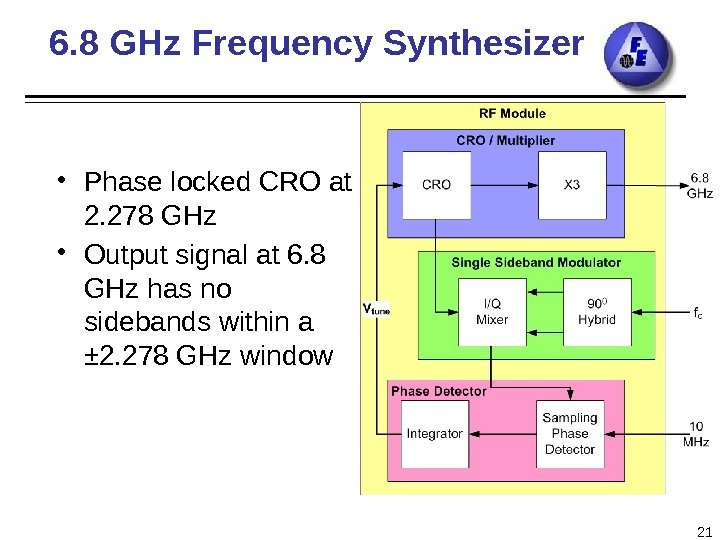
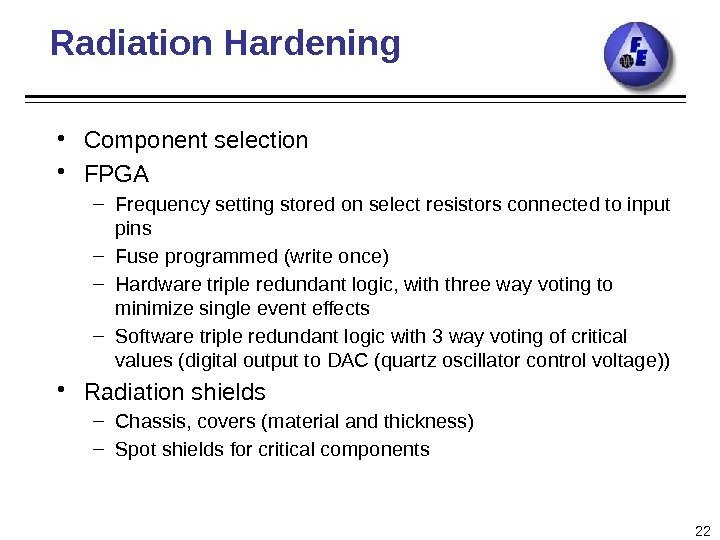
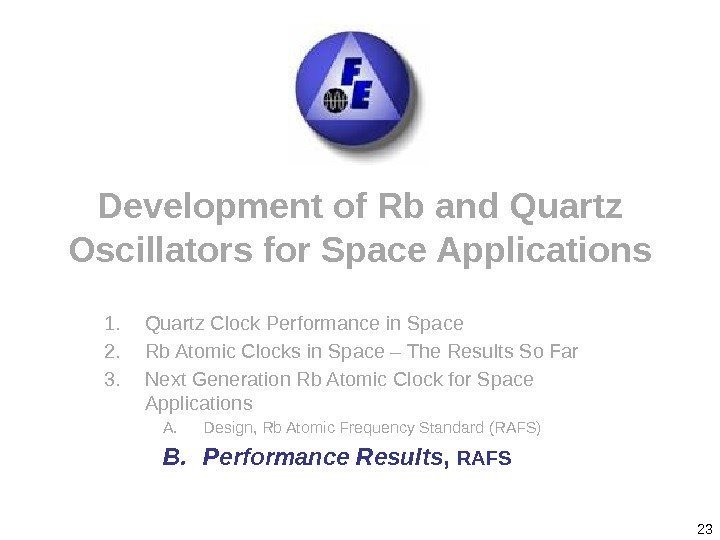
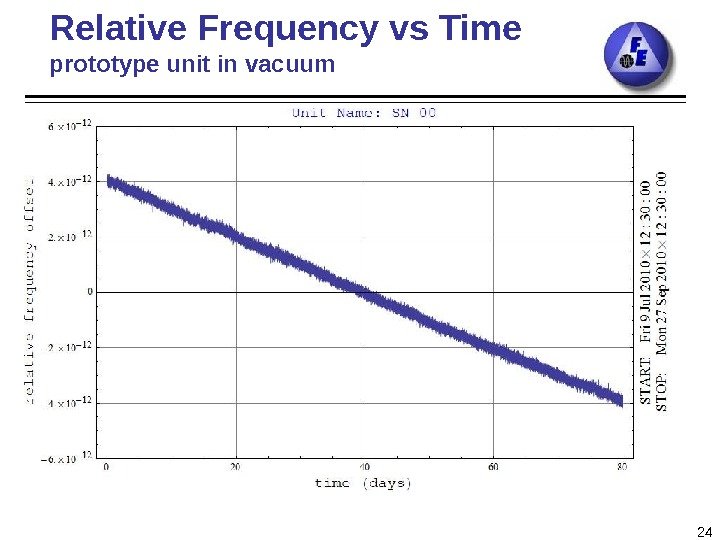
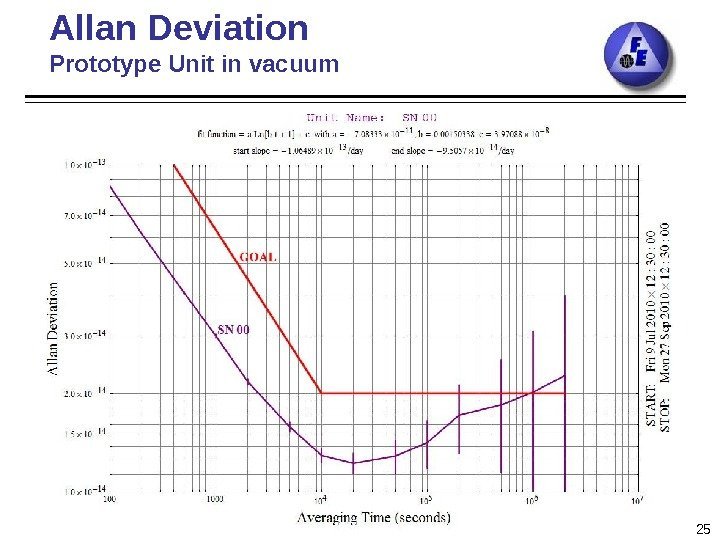
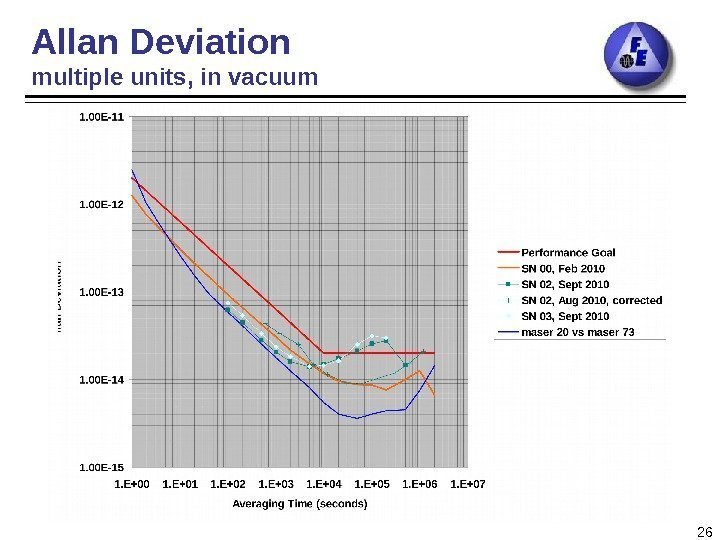
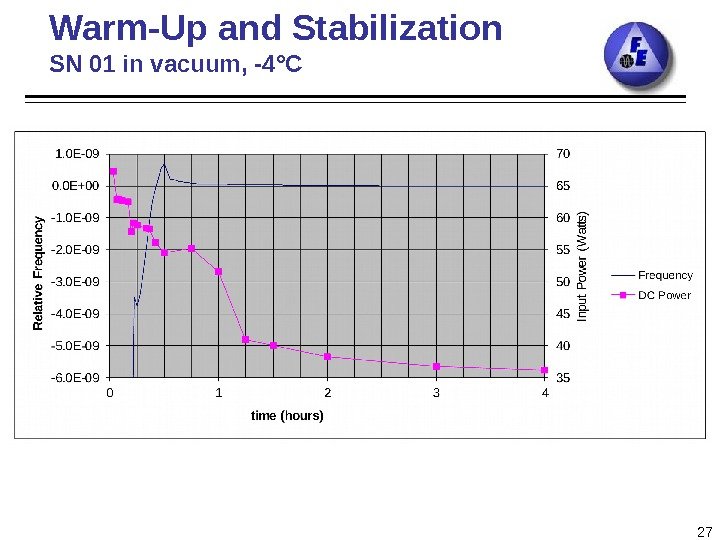
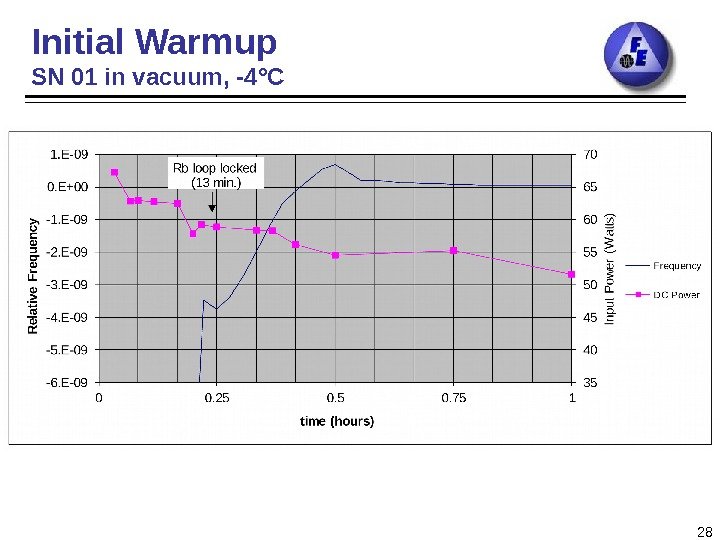
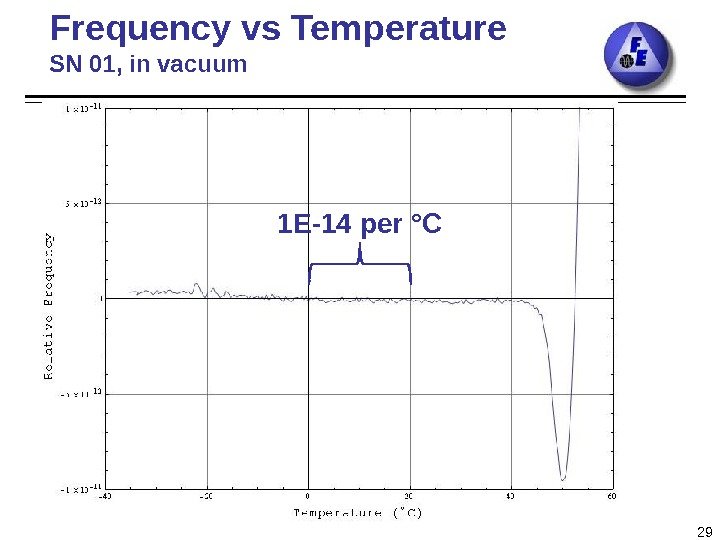
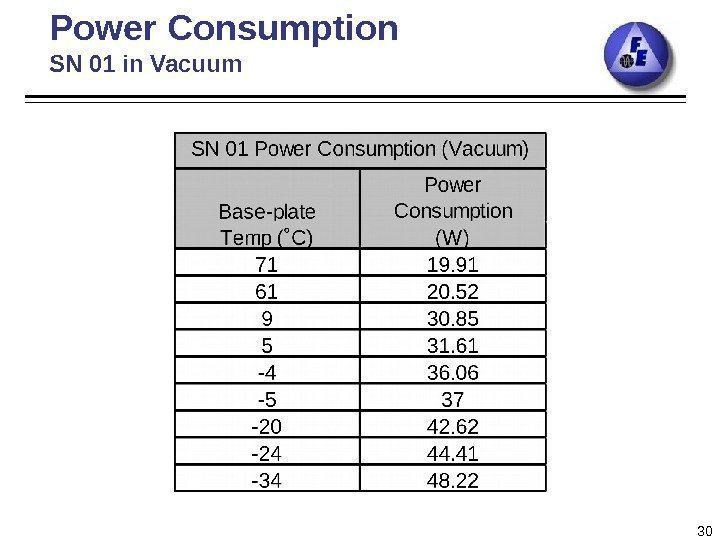
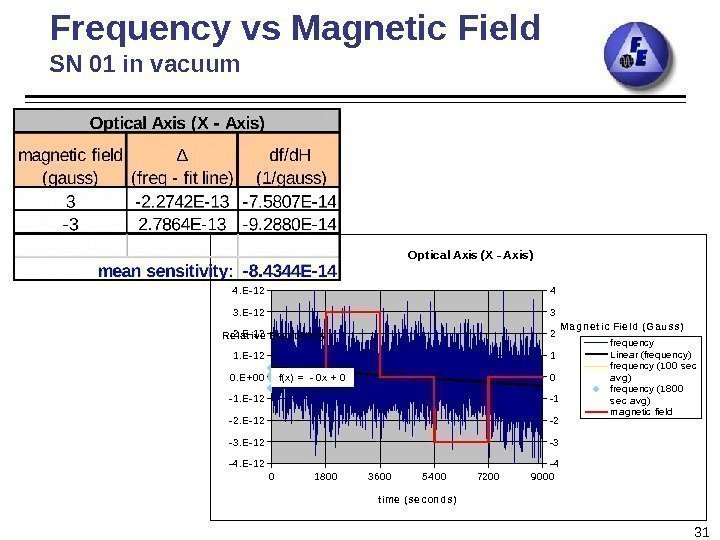
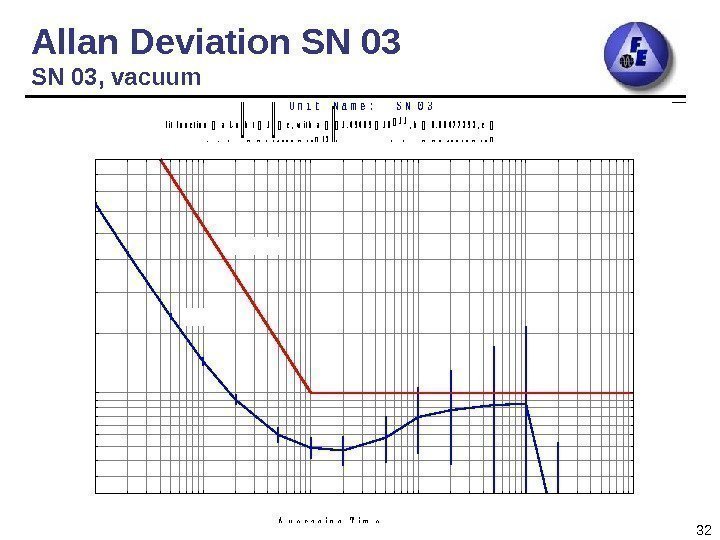
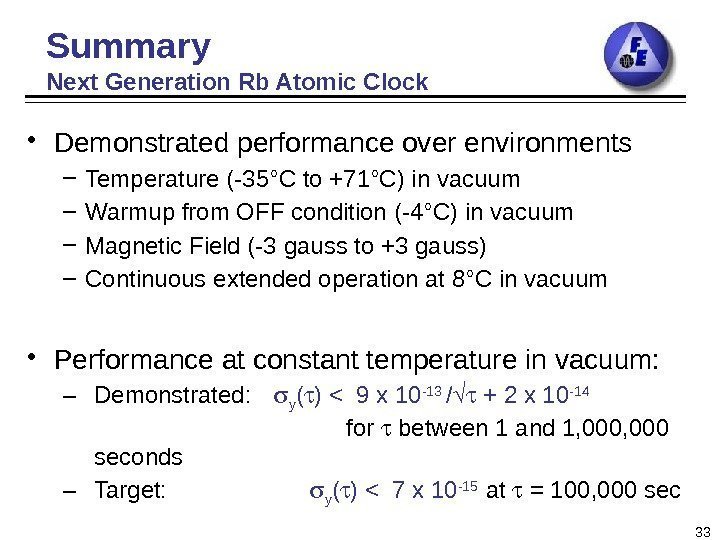
09_presentation,_russian_symposium,_rev_02.pptx
- Размер: 3.4 Мб
- Автор:
- Количество слайдов: 33
Описание презентации 1 FREQUENCY ELECTRONICS, INC. Rb and Quartz Oscillators по слайдам
 1 FREQUENCY ELECTRONICS, INC. Rb and Quartz Oscillators for Space Applications Martin Bloch
1 FREQUENCY ELECTRONICS, INC. Rb and Quartz Oscillators for Space Applications Martin Bloch
 2 Frequency Electronics, Inc. • FEI was started 51 years ago with a mission to bring precision timing technology from the laboratory to the real world • FEI is a Long-Recognized Technology Leader High Precision Timing, Space Applications Low Phase Noise Microwave Sources and Synthesizers Low “G”- Sensitivity Clocks Timing/Frequency Systems for Severe Environments
2 Frequency Electronics, Inc. • FEI was started 51 years ago with a mission to bring precision timing technology from the laboratory to the real world • FEI is a Long-Recognized Technology Leader High Precision Timing, Space Applications Low Phase Noise Microwave Sources and Synthesizers Low “G”- Sensitivity Clocks Timing/Frequency Systems for Severe Environments
 Development of Rb and Quartz Oscillators for Space Applications 1. Quartz Clock Performance in Space 2. Rb Atomic Clocks in Space – The Results So Far 3. Next Generation Rb Atomic Clock for Space Applications A. Design, Rb Atomic Frequency Standard (RAFS) B. Performance Results, RAFS
Development of Rb and Quartz Oscillators for Space Applications 1. Quartz Clock Performance in Space 2. Rb Atomic Clocks in Space – The Results So Far 3. Next Generation Rb Atomic Clock for Space Applications A. Design, Rb Atomic Frequency Standard (RAFS) B. Performance Results, RAFS
 Introduction • For the past 50 years, most satellite systems have used precision quartz oscillators as the time and frequency reference – Reliable – Low Power – Light Weight • Atomic Frequency Standards have demonstrated reliable operation in space during the last 25 years on a limited number of programs – GPS – Glonass – Milstar/AEHF – Galileo
Introduction • For the past 50 years, most satellite systems have used precision quartz oscillators as the time and frequency reference – Reliable – Low Power – Light Weight • Atomic Frequency Standards have demonstrated reliable operation in space during the last 25 years on a limited number of programs – GPS – Glonass – Milstar/AEHF – Galileo
 Technology Trade-offs • Quartz oscillators are the most reliable, lowest cost technology for providing precision frequency and time in space applications • Quartz is inherently sensitive to nuclear radiation • Atomic frequency standards cost more, are less reliable, but provide improved frequency stability, and are relatively immune to radiation
Technology Trade-offs • Quartz oscillators are the most reliable, lowest cost technology for providing precision frequency and time in space applications • Quartz is inherently sensitive to nuclear radiation • Atomic frequency standards cost more, are less reliable, but provide improved frequency stability, and are relatively immune to radiation
 6 Development of Rb and Quartz Oscillators for Space Applications 1. Quartz Clock Performance in Space 2. Rb Atomic Clocks in Space – The Results So Far 3. Next Generation Rb Atomic Clock for Space Applications A. Design, Rb Atomic Frequency Standard (RAFS) B. Performance Results, RAFS
6 Development of Rb and Quartz Oscillators for Space Applications 1. Quartz Clock Performance in Space 2. Rb Atomic Clocks in Space – The Results So Far 3. Next Generation Rb Atomic Clock for Space Applications A. Design, Rb Atomic Frequency Standard (RAFS) B. Performance Results, RAFS
 State of the Art Quartz Performance in Space • Usage of “Premium Q Swept Quartz” or radiation hardened quartz material. • SC-cut crystals (SC-cut crystals stabilize faster than AT-cut crystals. The retrace of SC-cut crystals is orders of magnitude better than AT-cut crystals). • 5 th overtone resonators (aging is significantly affected by the thickness of the resonator, hence, the thickest quartz blank should be used at the highest practical overtone for best aging performance). • Crystals exhibiting monotonically-positive aging slope (radiation offsets the positive aging trend of quartz as further explained below).
State of the Art Quartz Performance in Space • Usage of “Premium Q Swept Quartz” or radiation hardened quartz material. • SC-cut crystals (SC-cut crystals stabilize faster than AT-cut crystals. The retrace of SC-cut crystals is orders of magnitude better than AT-cut crystals). • 5 th overtone resonators (aging is significantly affected by the thickness of the resonator, hence, the thickest quartz blank should be used at the highest practical overtone for best aging performance). • Crystals exhibiting monotonically-positive aging slope (radiation offsets the positive aging trend of quartz as further explained below).
 Radiation Effects on Quartz • Quartz sensitivity to most radiation has been shown to be approximately: -1 E-12 per Rad • Typical background radiation for geosynchronous orbit is: 6 Rads/day • Typical frequency aging on earth is ~1 E-11/day for high precision quartz oscillators • On-orbit compensation resulting in frequency aging of ~1 E-12/day is possible for positive aging quartz resonators • Quartz sensitivity to protons is similar magnitude, but less predictable; and can result in positive or negative frequency changes 8 Even with compensation for background radiation: • best performance observed in space is ~2 E-13/day • effect of solar flare is 1 E-10 to 4 E-10 over several days
Radiation Effects on Quartz • Quartz sensitivity to most radiation has been shown to be approximately: -1 E-12 per Rad • Typical background radiation for geosynchronous orbit is: 6 Rads/day • Typical frequency aging on earth is ~1 E-11/day for high precision quartz oscillators • On-orbit compensation resulting in frequency aging of ~1 E-12/day is possible for positive aging quartz resonators • Quartz sensitivity to protons is similar magnitude, but less predictable; and can result in positive or negative frequency changes 8 Even with compensation for background radiation: • best performance observed in space is ~2 E-13/day • effect of solar flare is 1 E-10 to 4 E-10 over several days
 State of the Art Quartz Oscillator 9 -133 • L ᵠ (f) = -133 d. BC/Hz @ 1 Hz offset • ADEV = 7 E-14 @ 10 sec
State of the Art Quartz Oscillator 9 -133 • L ᵠ (f) = -133 d. BC/Hz @ 1 Hz offset • ADEV = 7 E-14 @ 10 sec
 10 Development of Rb and Quartz Oscillators for Space Applications 1. Quartz Clock Performance in Space 2. Rb Atomic Clocks in Space – The Results So Far 3. Next Generation Rb Atomic Clock for Space Applications A. Design, Rb Atomic Frequency Standard (RAFS) B. Performance Results, RAFS
10 Development of Rb and Quartz Oscillators for Space Applications 1. Quartz Clock Performance in Space 2. Rb Atomic Clocks in Space – The Results So Far 3. Next Generation Rb Atomic Clock for Space Applications A. Design, Rb Atomic Frequency Standard (RAFS) B. Performance Results, RAFS
 Overview 11 • Compared to crystal oscillators, atomic clocks are inherently insensitive to space radiation. 1 • Compared to other types of atomic clock (e. g. , Cs), • Rb clocks have the advantage of size, weight, and power, • Rb clocks have the (believed) disadvantage of relatively large frequency aging. • To better understand the utility of Rb clocks for long-term space missions, we have investigated Milstar Rb clocks (on-orbit) over the past two decades. • Contrary to popular mythology, • Rb clocks can have exceptionally long life with stable operation, • Rb clocks can have extremely low frequency-aging rates: 10 -14 to 10 -15 /day 1) J. Camparo, S. Moss, & S. La. Lumondiere, Space-system timekeeping in the presence of solar flares, IEEE Aerospace and Electronic SYSTEMS Magazine, 19 (5), 3 -8 (2004).
Overview 11 • Compared to crystal oscillators, atomic clocks are inherently insensitive to space radiation. 1 • Compared to other types of atomic clock (e. g. , Cs), • Rb clocks have the advantage of size, weight, and power, • Rb clocks have the (believed) disadvantage of relatively large frequency aging. • To better understand the utility of Rb clocks for long-term space missions, we have investigated Milstar Rb clocks (on-orbit) over the past two decades. • Contrary to popular mythology, • Rb clocks can have exceptionally long life with stable operation, • Rb clocks can have extremely low frequency-aging rates: 10 -14 to 10 -15 /day 1) J. Camparo, S. Moss, & S. La. Lumondiere, Space-system timekeeping in the presence of solar flares, IEEE Aerospace and Electronic SYSTEMS Magazine, 19 (5), 3 -8 (2004).
 Milstar Rb Clocks 12 • The Milstar Rb atomic clocks are manufactured by Frequency Electronics, Inc. (FEI) • The clock is a classical Rb vapor-cell design, with optical excitation using an rf-discharge lamp. 2 – The clock has a 10 year design life. – The clock has a weight of 2. 3 kg (i. e. , 5 lbs. ). – The clock frequency can be tuned with a resolution better than 1 10 -12. • 2) T. Mc. Clelland, I. Pascaru, M. Meirs, Development of a Rb Frequency Standard for the MILSTAR Satellite System, 41 st Annual Symposium on Frequency Control, 1987, p.
Milstar Rb Clocks 12 • The Milstar Rb atomic clocks are manufactured by Frequency Electronics, Inc. (FEI) • The clock is a classical Rb vapor-cell design, with optical excitation using an rf-discharge lamp. 2 – The clock has a 10 year design life. – The clock has a weight of 2. 3 kg (i. e. , 5 lbs. ). – The clock frequency can be tuned with a resolution better than 1 10 -12. • 2) T. Mc. Clelland, I. Pascaru, M. Meirs, Development of a Rb Frequency Standard for the MILSTAR Satellite System, 41 st Annual Symposium on Frequency Control, 1987, p.
 On-Orbit Data: Rb Satellite Clocks Functional Fit: y(t) = Ae — w t + Be — e t + Dt 13 • Empirically, we find that as a family the data is well fit by a bi-exponential plus linear term: • Clock “warm-up” – Ae — w t – This term may be due to movement of the liquid Rb pool in the discharge lamp. • Clock Equilibration 4 – Be — e t – The mechanism of equilibration is not yet understood. – Nevertheless, helium permeation remains an open possibility. • Linear Frequency Aging – Dt – The mechanism of linear frequency aging is not yet understood. Dt Be Ae tyt-t-ew
On-Orbit Data: Rb Satellite Clocks Functional Fit: y(t) = Ae — w t + Be — e t + Dt 13 • Empirically, we find that as a family the data is well fit by a bi-exponential plus linear term: • Clock “warm-up” – Ae — w t – This term may be due to movement of the liquid Rb pool in the discharge lamp. • Clock Equilibration 4 – Be — e t – The mechanism of equilibration is not yet understood. – Nevertheless, helium permeation remains an open possibility. • Linear Frequency Aging – Dt – The mechanism of linear frequency aging is not yet understood. Dt Be Ae tyt-t-ew
 • Six clocks have operated on orbit (data for three presented here) 4 • Longest operating time on-orbit is 14. 8 years • Including estimates for ground operation, 3 of these clocks have logged more than 18 years of operation! 14 Milstar Rb Satellite Clocks Summary 4) J. Camparo, T. Mc. Clelland, and J. Hagerman, “Long Term Behavior of Rb Clocks in Space, ” European Frequency and Time Forum, 2012.
• Six clocks have operated on orbit (data for three presented here) 4 • Longest operating time on-orbit is 14. 8 years • Including estimates for ground operation, 3 of these clocks have logged more than 18 years of operation! 14 Milstar Rb Satellite Clocks Summary 4) J. Camparo, T. Mc. Clelland, and J. Hagerman, “Long Term Behavior of Rb Clocks in Space, ” European Frequency and Time Forum, 2012.
 15 Development of Rb and Quartz Oscillators for Space Applications 1. Quartz Clock Performance in Space 2. Rb Atomic Clocks in Space – The Results So Far 3. Next Generation Rb Atomic Clock for Space Applications A. Design, Rb Atomic Frequency Standard (RAFS) B. Performance Results, RAFS
15 Development of Rb and Quartz Oscillators for Space Applications 1. Quartz Clock Performance in Space 2. Rb Atomic Clocks in Space – The Results So Far 3. Next Generation Rb Atomic Clock for Space Applications A. Design, Rb Atomic Frequency Standard (RAFS) B. Performance Results, RAFS
 Design Goals • Precision Rubidium Atomic Frequency Standard (RAFS) for Space Applications – Best possible frequency stability – 20 year operating life • Emphasis on frequency stability rather than size, weight and power (SWAP) • “ Classical” Rb vapor frequency standard – Optical pumping using Rb lamp to create ground state hyperfine population difference – Temperature controlled filter cell with Rb 85 – Temperature controlled resonance cell, with Rb 87 , in microwave cavity • One prototype, 3 engineering models
Design Goals • Precision Rubidium Atomic Frequency Standard (RAFS) for Space Applications – Best possible frequency stability – 20 year operating life • Emphasis on frequency stability rather than size, weight and power (SWAP) • “ Classical” Rb vapor frequency standard – Optical pumping using Rb lamp to create ground state hyperfine population difference – Temperature controlled filter cell with Rb 85 – Temperature controlled resonance cell, with Rb 87 , in microwave cavity • One prototype, 3 engineering models
 17 Development of Rb and Quartz Oscillators for Space Applications 1. Quartz Clock Performance in Space 2. Rb Atomic Clocks in Space – The Results So Far 3. Next Generation Rb Atomic Clock for Space Applications A. Design , Rb Atomic Frequency Standard (RAFS) B. Performance Results, RAFS
17 Development of Rb and Quartz Oscillators for Space Applications 1. Quartz Clock Performance in Space 2. Rb Atomic Clocks in Space – The Results So Far 3. Next Generation Rb Atomic Clock for Space Applications A. Design , Rb Atomic Frequency Standard (RAFS) B. Performance Results, RAFS
 Rb Atomic Frequency Standard (RAFS) 18 • 15 x 4. 6 x 5. 2 inches (381 x 117 x 132 mm) • 16. 5 Lbs (7. 5 kg) • 28 VDC Input • 30 Watts • 10 MHz Output
Rb Atomic Frequency Standard (RAFS) 18 • 15 x 4. 6 x 5. 2 inches (381 x 117 x 132 mm) • 16. 5 Lbs (7. 5 kg) • 28 VDC Input • 30 Watts • 10 MHz Output
 Block Diagram • Temperature controlled chassis ( ± 1°C) operates from -34°C to +25°C • Modular Design • Digital Rb control loop
Block Diagram • Temperature controlled chassis ( ± 1°C) operates from -34°C to +25°C • Modular Design • Digital Rb control loop
 Digital Rb Control Loop • Digital processing of analog signal from physics package • Space qualified FPGA • Direct Digital Synthesizer (within FPGA) to tune output frequency (1 x 10 -14 tuning resolution)
Digital Rb Control Loop • Digital processing of analog signal from physics package • Space qualified FPGA • Direct Digital Synthesizer (within FPGA) to tune output frequency (1 x 10 -14 tuning resolution)
 6. 8 GHz Frequency Synthesizer • Phase locked CRO at 2. 278 GHz • Output signal at 6. 8 GHz has no sidebands within a ± 2. 278 GHz window
6. 8 GHz Frequency Synthesizer • Phase locked CRO at 2. 278 GHz • Output signal at 6. 8 GHz has no sidebands within a ± 2. 278 GHz window
 Radiation Hardening • Component selection • FPGA – Frequency setting stored on select resistors connected to input pins – Fuse programmed (write once) – Hardware triple redundant logic, with three way voting to minimize single event effects – Software triple redundant logic with 3 way voting of critical values (digital output to DAC (quartz oscillator control voltage)) • Radiation shields – Chassis, covers (material and thickness) – Spot shields for critical components
Radiation Hardening • Component selection • FPGA – Frequency setting stored on select resistors connected to input pins – Fuse programmed (write once) – Hardware triple redundant logic, with three way voting to minimize single event effects – Software triple redundant logic with 3 way voting of critical values (digital output to DAC (quartz oscillator control voltage)) • Radiation shields – Chassis, covers (material and thickness) – Spot shields for critical components
 23 Development of Rb and Quartz Oscillators for Space Applications 1. Quartz Clock Performance in Space 2. Rb Atomic Clocks in Space – The Results So Far 3. Next Generation Rb Atomic Clock for Space Applications A. Design, Rb Atomic Frequency Standard (RAFS) B. Performance Results , RAFS
23 Development of Rb and Quartz Oscillators for Space Applications 1. Quartz Clock Performance in Space 2. Rb Atomic Clocks in Space – The Results So Far 3. Next Generation Rb Atomic Clock for Space Applications A. Design, Rb Atomic Frequency Standard (RAFS) B. Performance Results , RAFS
 Relative Frequency vs Time prototype unit in vacuum
Relative Frequency vs Time prototype unit in vacuum
 Allan Deviation Prototype Unit in vacuum
Allan Deviation Prototype Unit in vacuum
 26 Allan Deviation multiple units, in vacuum
26 Allan Deviation multiple units, in vacuum
 Warm-Up and Stabilization SN 01 in vacuum, -4 °
Warm-Up and Stabilization SN 01 in vacuum, -4 °
 28 Initial Warmup SN 01 in vacuum, -4 °
28 Initial Warmup SN 01 in vacuum, -4 °
 Frequency vs Temperature SN 01, in vacuum 291 E-14 per °
Frequency vs Temperature SN 01, in vacuum 291 E-14 per °
 Power Consumption SN 01 in Vacuum
Power Consumption SN 01 in Vacuum
 Frequency vs Magnetic Field SN 01 in vacuum 310 1800 3600 54 00 7200 9000 -4. E-12 -3. E-12 -2. E-12 -1. E-12 0. E+ 00 1. E-122. E-123. E-124. E-12 -4 -3 -2 -101234 f(x) = — 0 x + 0 Opt ica l Axis (X — Axis) fre q ue nc y Line a r (fre q ue nc y ) fre q ue nc y (10 0 s e c a v g ) fre q ue nc y (18 0 0 s e c a v g ) ma g ne tic fie ld t ime (se conds)Re la t ive Fre que ncy Ma gne t ic Fie ld (G a uss)
Frequency vs Magnetic Field SN 01 in vacuum 310 1800 3600 54 00 7200 9000 -4. E-12 -3. E-12 -2. E-12 -1. E-12 0. E+ 00 1. E-122. E-123. E-124. E-12 -4 -3 -2 -101234 f(x) = — 0 x + 0 Opt ica l Axis (X — Axis) fre q ue nc y Line a r (fre q ue nc y ) fre q ue nc y (10 0 s e c a v g ) fre q ue nc y (18 0 0 s e c a v g ) ma g ne tic fie ld t ime (se conds)Re la t ive Fre que ncy Ma gne t ic Fie ld (G a uss)
 G O A L S N 0 3 1 0 0 01 041 051 061 071. 01 01 4 1. 01 01 3 5. 01 01 4 2. 01 01 4 3. 01 01 4 1. 51 01 4 7. 01 01 4 A v e r a g i n g. T i m es e c o n d s U n i t. N a m e: S N 0 3 f i tf u n c t i o na. L nbt 1 c, w i t ha 1. 6 9 6 0 91 01 1, b 0. 0 0 6 7 7 3 9 3, c 1. 0 1 4 0 61 09 s t a r ts l o p e 1. 1 4 8 9 21 01 3 d a ye n ds l o p e 8. 6 7 0 1 31 01 4 d a y START: Sun 19 Sep 2010 23 : 58 : 20 STOP: Sat 6 Nov 2010 23 : 58 : 2032 Allan Deviation SN 03, vacuum
G O A L S N 0 3 1 0 0 01 041 051 061 071. 01 01 4 1. 01 01 3 5. 01 01 4 2. 01 01 4 3. 01 01 4 1. 51 01 4 7. 01 01 4 A v e r a g i n g. T i m es e c o n d s U n i t. N a m e: S N 0 3 f i tf u n c t i o na. L nbt 1 c, w i t ha 1. 6 9 6 0 91 01 1, b 0. 0 0 6 7 7 3 9 3, c 1. 0 1 4 0 61 09 s t a r ts l o p e 1. 1 4 8 9 21 01 3 d a ye n ds l o p e 8. 6 7 0 1 31 01 4 d a y START: Sun 19 Sep 2010 23 : 58 : 20 STOP: Sat 6 Nov 2010 23 : 58 : 2032 Allan Deviation SN 03, vacuum
 Summary Next Generation Rb Atomic Clock • Demonstrated performance over environments – Temperature (-35°C to +71°C) in vacuum – Warmup from OFF condition (-4°C) in vacuum – Magnetic Field (-3 gauss to +3 gauss) – Continuous extended operation at 8°C in vacuum • Performance at constant temperature in vacuum: – Demonstrated: y ( ) < 9 x 10 -13 / + 2 x 10 -14 for between 1 and 1, 000 seconds – Target: y ( ) < 7 x 10 -15 at = 100, 000 sec
Summary Next Generation Rb Atomic Clock • Demonstrated performance over environments – Temperature (-35°C to +71°C) in vacuum – Warmup from OFF condition (-4°C) in vacuum – Magnetic Field (-3 gauss to +3 gauss) – Continuous extended operation at 8°C in vacuum • Performance at constant temperature in vacuum: – Demonstrated: y ( ) < 9 x 10 -13 / + 2 x 10 -14 for between 1 and 1, 000 seconds – Target: y ( ) < 7 x 10 -15 at = 100, 000 sec
